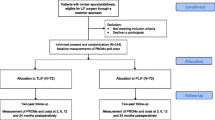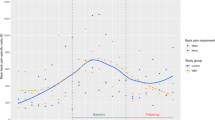Abstract
Although cost-effectiveness is becoming the foremost evaluative criterion within health service management of spine surgery, scientific knowledge about cost-patterns and cost-effectiveness is limited. The aims of this study were (1) to establish an activity-based method for costing at the patient-level, (2) to investigate the correlation between costs and effects, (3) to investigate the influence of selected patient characteristics on cost-effectiveness and, (4) to investigate the incremental cost-effectiveness ratio of (a) posterior instrumentation and (b) intervertebral anterior support in lumbar spinal fusion. We hypothesized a positive correlation between costs and effects, that determinants of effects would also determine cost-effectiveness, and that posterolateral instrumentation and anterior intervertebral support are cost-effective adjuncts in posterolateral lumbar fusion. A cohort of 136 consecutive patients with chronic low back pain, who were surgically treated from January 2001 through January 2003, was followed until 2 years postoperatively. Operations took place at University Hospital of Aarhus and all patients had either (1) non-instrumented posterolateral lumbar spinal fusion, (2) instrumented posterolateral lumbar spinal fusion, or (3) instrumented posterolateral lumbar spinal fusion + anterior intervertebral support. Analysis of costs was performed at the patient-level, from an administrator’s perspective, by means of Activity-Based-Costing. Clinical effects were measured by means of the Dallas Pain Questionnaire and the Low Back Pain Rating Scale at baseline and 2 years postoperatively. Regression models were used to reveal determinants for costs and effects. Costs and effects were analyzed as a net-benefit measure to reveal determinants for cost-effectiveness, and finally, adjusted analysis (for non-random allocation of patients) was performed in order to reveal the incremental cost-effectiveness ratios of (a) posterior instrumentation and (b) anterior support. The costs of non-instrumented posterolateral spinal fusion were estimated at DKK 88,285(95% CI 81,369;95,546), instrumented posterolateral spinal fusion at DKK 94,396(95% CI 89,865;99,574) and instrumented posterolateral lumbar spinal fusion + anterior intervertebral support at DKK 120,759(95% CI 111,981;133,738). The net-benefit of the regimens was significantly affected by smoking and functional disability in psychosocial life areas. Multi-level fusion and surgical technique significantly affected the net-benefit as well. Surprisingly, no correlation was found between treatment costs and treatment effects. Incremental analysis suggested that the probability of posterior instrumentation being cost-effective was limited, whereas the probability of anterior intervertebral support being cost-effective escalates as willingness-to-pay per effect unit increases. This study reveals useful and hitherto unknown information both about cost-patterns at the patient-level and determinants of cost-effectiveness. The overall conclusion of the present investigation is a recommendation to focus further on determinants of cost-effectiveness. For example, patient characteristics that are modifiable at a relatively low expense may have greater influence on cost-effectiveness than the surgical technique itself—at least from an administrator’s perspective.





Similar content being viewed by others
Notes
With the exception of hospitalizations exceeding a specific trimming point, which rarely has direct application (26 days in non-instrumented fusion and 23 days in instrumented and circumferential fusion).
References
Andrews DWK, Buchinsky M (2000) A three-step method for choosing the number of bootstrap repetitions. Econometrica 68:23–51
Black WC (1990) The CE plane: a graphic representation of cost-effectiveness. Med Decis Making 10:212–214
Christensen FB, Hansen ES, Eiskjaer SP, Hoy K, Helmig P, Neumann P et al (2002) Circumferential lumbar spinal fusion with Brantigan cage versus posterolateral fusion with titanium Cotrel-Dubousset instrumentation: a prospective, randomized clinical study of 146 patients. Spine 27:2674–2683
Christensen FB, Hansen ES, Laursen M, Thomsen K, Bunger CE (2002) Long-term functional outcome of pedicle screw instrumentation as a support for posterolateral spinal fusion: randomized clinical study with a 5-year follow-up. Spine 27:1269–1277
Efron B, Tibshirani RJ (1993) An introduction to bootstrap. Chapman and Hall, New York
Fairbank JC, Pynsent PB (2000) The oswestry disability index. Spine 25:2940–2952
Fenwick E, O’Brien BJ, Briggs A (2004) Cost-effectiveness acceptability curves–facts, fallacies and frequently asked questions. Health Econ 13:405–415
Fischgrund JS, Mackay M, Herkowitz HN, Brower R, Montgomery DM, Kurz LT (1997) Volvo Award winner in clinical studies. Degenerative lumbar spondylolisthesis with spinal stenosis, a prospective, randomized study comparing decompressive laminectomy and arthrodesis with and without spinal instrumentation. Spine 22:2807–2812
Fritzell P, Hagg O, Jonsson D, Nordwall A (2004) Cost-effectiveness of lumbar fusion and nonsurgical treatment for chronic low back pain in the Swedish Lumbar Spine Study: a multicenter, randomized, controlled trial from the Swedish Lumbar Spine Study Group. Spine 29:421–434
Fritzell P, Hagg O, Wessberg P, Nordwall A (2002) Chronic low back pain and fusion: a comparison of three surgical techniques: a prospective multicenter randomized study from the Swedish lumbar spine study group. Spine 27:1131–1141
Hoch JS, Briggs AH, Willan AR (2002) Something old, something new, something borrowed, something blue: a framework for the marriage of health econometrics and cost-effectiveness analysis. Health Econ 11:415–430
Katz JN, Lipson SJ, Lew RA, Grobler LJ, Weinstein JN, Brick GW et al (1997) Lumbar laminectomy alone or with instrumented or noninstrumented arthrodesis in degenerative lumbar spinal stenosis. Patient selection, costs, and surgical outcomes. Spine 22:1123–1131
Kuntz KM, Snider RK, Weinstein JN, Pope MH, Katz JN (2000) Cost-effectiveness of fusion with and without instrumentation for patients with degenerative spondylolisthesis and spinal stenosis. Spine 25:1132–1139
Larsen J, Skjoldborg US (2004) Comparing systems for costing hospital treatments, the case of stable angina pectoris. Health Policy 67:293–307
Lawlis GF, Cuencas R, Selby D, McCoy CE (1989) The development of the Dallas Pain Questionnaire. An assessment of the impact of spinal pain on behavior. Spine 14:511–516
Lothgren M, Zethraeus N (2000) Definition, interpretation and calculation of cost-effectiveness acceptability curves. Health Econ 9:623–630
Manniche C, Asmussen K, Lauritsen B, Vinterberg H, Kreiner S, Jordan A (1994) Low back pain rating scale: validation of a tool for assessment of low back pain. Pain 57:317–326
Moller H, Hedlund R (2000) Instrumented and noninstrumented posterolateral fusion in adult spondylolisthesis—a prospective randomized study: part 2. Spine 25:1716–1721
O’Brien BJ, Drummond MF, Labelle RJ, Willan A (1994) In search of power and significance: issues in the design and analysis of stochastic cost-effectiveness studies in health care. Med Care 32:150–163
Rivero-Arias O, Campbell H, Gray A, Fairbank J, Frost H, Wilson-MacDonald J (2005) Surgical stabilisation of the spine compared with a programme of intensive rehabilitation for the management of patients with chronic low back pain: cost utility analysis based on a randomised controlled trial. BMJ 330:1239
Stinnett AA, Mullahy J (1998) Net health benefits: a new framework for the analysis of uncertainty in cost-effectiveness analysis. Med Decis Making 18:S68–S80
The Danish National Board of Health [Internet database] (2004) The Danish National Board of Health: Landspatientregistret. c2004—[cited 2004 Aug 19]. Available from: http://www.sstdk
Thomsen K, Christensen FB, Eiskjaer SP, Hansen ES, Fruensgaard S, Bunger CE (1997) Volvo Award winner in clinical studies. The effect of pedicle screw instrumentation on functional outcome and fusion rates in posterolateral lumbar spinal fusion, a prospective, randomized clinical study. Spine 22:2813–2822
Willan AR, O’Brien BJ (1999) Sample size and power issues in estimating incremental cost-effectiveness ratios from clinical trials data. Health Econ 8:203–211
Author information
Authors and Affiliations
Corresponding author
Rights and permissions
About this article
Cite this article
Soegaard, R., Christensen, F.B., Christiansen, T. et al. Costs and effects in lumbar spinal fusion. A follow-up study in 136 consecutive patients with chronic low back pain. Eur Spine J 16, 657–668 (2007). https://doi.org/10.1007/s00586-006-0179-8
Received:
Revised:
Accepted:
Published:
Issue Date:
DOI: https://doi.org/10.1007/s00586-006-0179-8




